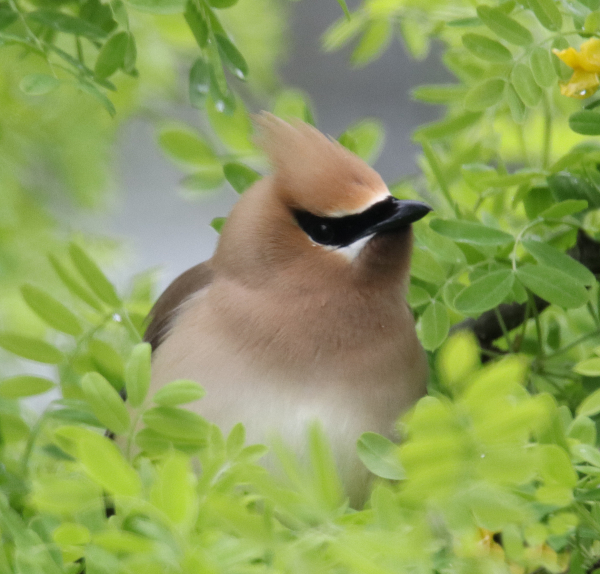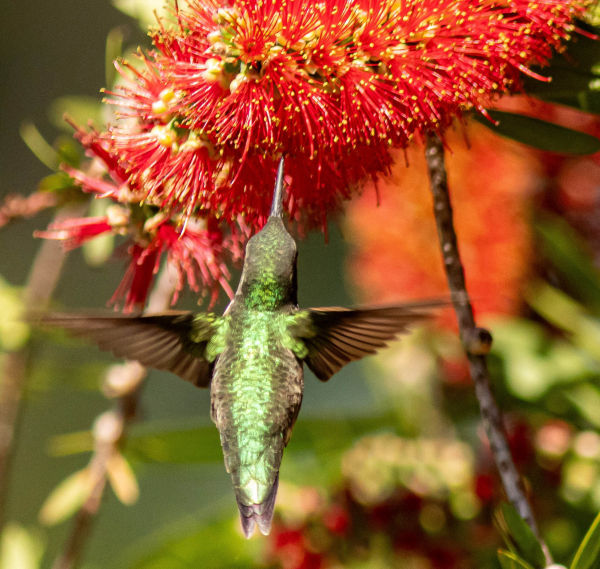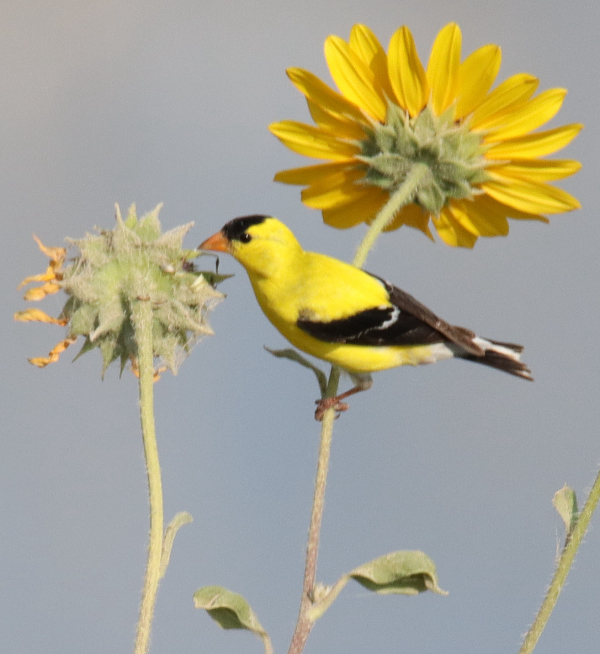
It’s a good time to add a few key plants that can attract some dispersing birds, like this Cedar Waxwing (photo by Paul Konrad).

Bee balm flowers are a real magnet for hummingbirds (photo by Donald Thompson).

Some nurseries offer sunflowers in containers during mid-summer that can be favorite summer additions to your yard; for you and birds, including goldfinches (photo by Paul Konrad).
|
As July edges toward August, our yards should be flourishing and robust with new growth and an abundance of flowers. It’s also time to be alert for new birds arriving in your yard as many birds are dispersing from nesting territories to the north, including a new cohort of recent fledglings making their first movements south. What birds are you expecting? Hummingbirds, finches, orioles, thrushes, native sparrows, towhees, bluebirds, cardinals? With dispersing birds in mind, it’s a good time to add a few key plants that can attract some new and returning birds.
For example, hummingbirds don’t nest in our area, but they spend several weeks during August and September in our neighborhood, feeding on flower nectar, the tiny insects and spiders that flowers attract, and visiting our nectar feeders – one in the front yard, one in the back. At this time, most birds are still feeding on bugs, even the birds we often expect are eating seeds as they do during the fall, winter, and early spring seasons. Therefore, the more plants, including flowering plants, the greater the variety of birds you will see in your yard.
Imagine a dispersing or migrating bird that’s lucky enough to find your beautifully landscaped yard – a true haven for feeding, resting, cooling in the shade. It’s a good time to take another look at your current flowering plants – what’s flowering, and what will the days of August and September produce – more or fewer flowers? It’s always fun to visit a greenhouse or another plant supply store to see what’s in bloom and ask what will be blooming in coming weeks into early fall.
To focus on attracting and benefitting hummingbirds, emphasize additions of red tubular flowers, especially plants like red salvia, cardinal flowers, bee balm, and red trumpet vines – these are real hummingbird magnets, and the more you have the longer hummingbirds will be active among them. For us, there is something special about seeing hummingbirds feeding from flowers; perhaps it’s just a more natural activity than having them zero in on a nectar feeder. Don’t get us wrong, that’s important and enjoyable too, but just as it’s nice to see the hummers feeding from flower to flower, it’s nice to have the flowers lining the way as we walk along the sides of our house, sidewalk, and garage, as well as the flower beds that accent our yard with color.
This time of year, some nurseries offer flowering sunflower plants for sale in individual pots. Sometimes they even offer sunflowers with large, well developed seed heads. One, a couple, or a few of these container sunflowers can add a new dimension to an area of your yard, adding a flash of color and a new landscaping element that will benefit birds that will feed on the seeds as they mature nearer to the fall season.
It’s always fun to introduce stylish pots filled with a variety of colorful flowers. Decorative pots can add design, style, and color to select locations, and they can attract hummingbirds – especially if you choose red tubular flowers – but hummers and other birds will search for insects on any flowering plants’ leaves, stems, and flowers too. We like to position 3 pots of differing heights and shapes together to add dimension and a point of interest in a couple areas of our yard. A true bonus to utilizing potted plants is that they are easy to move to another location, any time you choose to make a change.
When you think of it, your feeding station with its water container are part of your landscaping too. We think our feeders and water vessels should be as attractive looking to other people as other elements of our landscaping. It’s always worthwhile to consider if something is missing from your feeding station, if something needs an upgrade, or if something needs to be rearranged.
Summer foods and fresh water are just as important as when you provide these important elements during winter; and during summer it’s easier to keep the area looking like a part of your yard’s natural appeal. You can even brighten up your feeding station by positioning some attractive potted plants in strategic positions, or give some thought to another way of “decorating” the area.
In addition to the lush plants around your yard, you may be interested in creating a small area of dry dirt in an open area – a dust bath that some birds will utilize. At the same time, adding a new bird bath or another elevated shallow bowl of water is always a plus for birds that find your yard.
Adding a large decorative piece of driftwood, positioned horizontally or vertically, or a decorative log, boulder, or pile of rocks can provide focal elements that draw your eye a given location in your yard. You can even “plant” an attractive branch vertically, anchoring it in the ground, to provide an open perch for birds. You will especially appreciate that new perch when kingbirds or other flycatchers use the location to “hawk” insects on the wing and return to the perch. Wrens, robins, and other songbirds will sing from these perches, and even hummingbirds will take a rest on one periodically.
At this time of the summer, your spring plantings may be flourishing; but if not, it’s a good time to replant if you lose a plant or if a plant’s flowering season has passed. Then too, you can always expand existing garden areas, or add a new flower garden plot to an “empty corner” of your yard.
With mid-summer yard improvements in mind, a couple simple additions can really add to your appreciation of the beauty of your yard. It can also be a contribution to the collective improvements all birders can make, and are making, that add up to be a real conservation boost for birds – continent-wide. It’s a nice theme to think about when you take time to sit back and relax, absorbing the aesthetic qualities of the yard you have created and continue to improve – in the company of birds you have attracted and benefitted in the process.
Share your backyard birding experiences and photos with The Birding Wire at editorstbw2@gmail.com